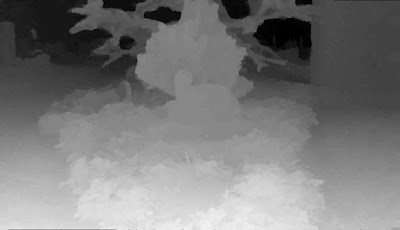Automatic depth map generation, stereo matching, multi-view stereo, Structure from Motion (SfM), photogrammetry, 2d to 3d conversion, etc. Check the "3D Software" tab for my free 3d software. Turn photos into paintings like impasto oil paintings, cel shaded cartoons, or watercolors. Check the "Painting Software" tab for my image-based painting software. Problems running my software? Send me your input data and I will do it for you.
Wednesday, June 22, 2016
3D Photos - Stevenson tombstone
I took the pictures with my Fuji W3, opened the mpo in StereoPhoto Maker, reduced the size to 1200 (in width), and rectified the reduced-size stereo pair with ER9b. I think I could have gone without the rectification process but ER9b gave me the min and max disparities, which is nice (no need to use DF2).
Time to get the depth/disparity map. First, I am gonna use DMAG5.
Input for DMAG5:
min disparity = -29
max disparity = 25
radius = 16
alpha = 0.9
truncation cost (color) = 20.0
truncation cost (gradient) = 10.0
epsilon = 4
disparity tolerance = 0
radius (occlusion smoothing) = 9
sigma space (occlusion smoothing) = 9.0
sigma color (occlusion smoothing) = 25.5
downsampling factor = 1
I guess one could play around with the radius to get different depth maps. There's no need to play with any of the other parameters.
Now, let's get the depth/disparity map with DMAG6.
Input for DMAG6:
min disparity = -29
max disparity = 25
alpha = 0.9
truncation cost (color) = 20.
truncation cost (gradient) = 10.
truncation cost (discontinuity) = 10000.
level number = 5
iteration number = 5
data cost weight = 0.5
disparity tolerance = 0
radius (occlusion smoothing) = 9
sigma space (occlusion smoothing) = 9.0
sigma color (occlusion smoothing) = 25.5
downsampling factor = 1
I guess one could play with the data cost weight to get different depth maps. There's no need to play with any of the other parameters.
Not a whole lot of difference between the depth map produced by DMAG5 and the one produced by DMAG6, so I used the depth map produced by DMAG5 in what follows.
I think the animated gifs are cool but there's another swell thing one can do with depth maps: shallow depth-of-field effect for miniature faking (tilt-shift).
Subscribe to:
Post Comments (Atom)






No comments:
Post a Comment